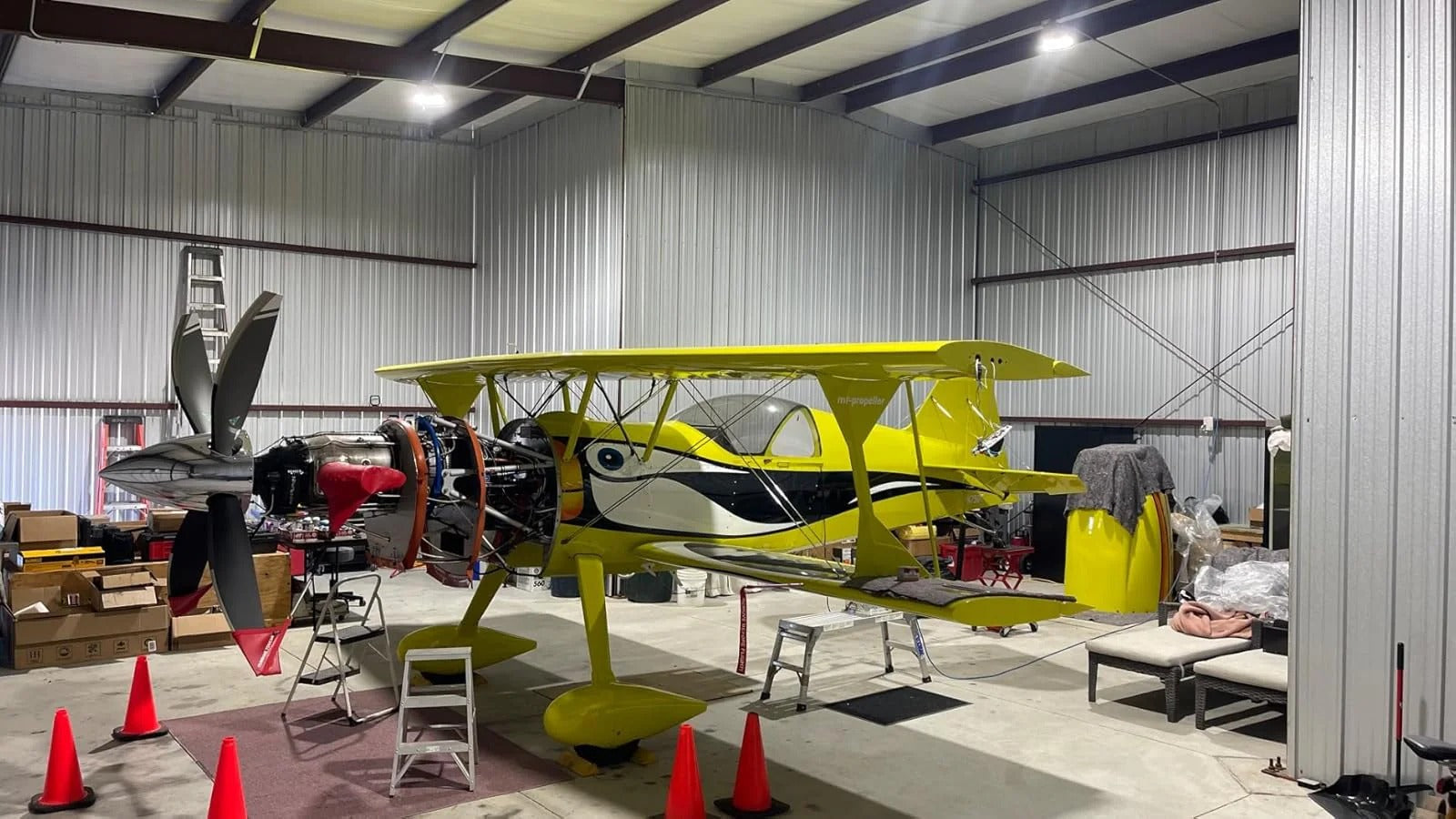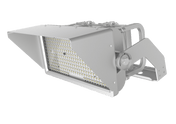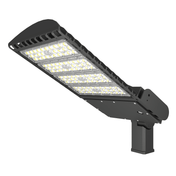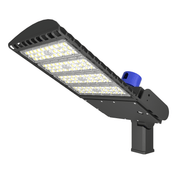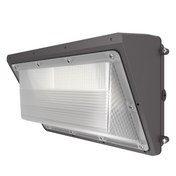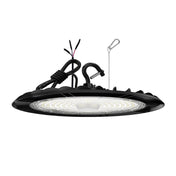Introduction
In modern industry and commerce, LED high bay lights play a vital role and are indispensable lighting equipment. Whether in tall and spacious factory halls, warehouses piled high with goods, crowded shopping malls and supermarkets, or vibrant stadiums, LED high bay lights, with their outstanding performance, provide sufficient and stable illumination for these spaces, ensuring the smooth progress of production, shopping, exercise, and other activities.
Imagine a large factory. Inadequate lighting can make it difficult for workers to see details on the production line, resulting in reduced production efficiency and even product quality issues. Worse still, dim light can cause safety accidents and threaten workers' lives. Similarly, in shopping malls, poor lighting can hinder customers' ability to clearly see products, undoubtedly affecting their shopping experience and potentially leading to reduced sales. The emergence of LED high bay lights has perfectly addressed these issues. With their high brightness, energy efficiency, and long life, they have become the preferred choice for lighting large spaces.
However, if you're not careful when purchasing LED high bay lights, you can easily fall into some misunderstandings. Not only can the purchased fixtures not meet your actual needs, but they can also cause financial losses. Below, we'll delve into some common mistakes to avoid when purchasing LED high bay lights, helping you make informed purchasing decisions and select the most suitable LED high bay lights for your space.
Mistake 1: Blindly Pursuing High Brightness
High brightness isn't necessarily the best choice
When purchasing LED mining lights, many people fall into the misconception that higher brightness is better. However, this isn't the case. Different industrial and mining environments have distinct lighting requirements. In some scenarios, high brightness may not only not be an advantage, but may even have a negative impact.
Take textile workshops, for example. Textile work often involves delicate tasks, requiring workers to concentrate for extended periods of time. If the lighting brightness is too high, glare will be generated, causing discomfort in workers' eyes, even soreness and tearing, which in turn affects visual comfort and work efficiency. Long-term work in such an environment may also damage workers' eyesight. Furthermore, excessive brightness can impair workers' ability to discern color, a serious problem for textile processes with demanding color requirements, potentially leading to product quality deviations.
For example, while warehouses require adequate lighting to facilitate the storage and handling of goods, if brightness exceeds the appropriate range, workers experiencing visual fatigue while walking through the warehouse can experience this. This is especially true when workers suddenly enter a brighter area from a darker one. The eyes need time to adjust, making collisions and other safety accidents more likely to occur during this period.
How to Correctly Select Brightness
So, how can we choose the right brightness for LED high bay lights? This requires scientific calculations based on actual needs and site conditions.
First, we must understand two important concepts: luminous flux and illuminance. Luminous flux refers to the total amount of light emitted by a light source, measured in lumens (lm), reflecting its luminous capacity. Illuminance refers to the amount of light received per unit area, measured in lux (lx), measuring the brightness of the illuminated surface.
We can calculate the required luminous flux using the following formula: Luminous flux (lm) = illuminance (lx) × area (m²) ÷ utilization factor × maintenance factor. The utilization factor depends on factors such as lamp type, mounting height, room size, and reflectivity, and generally ranges from 0.3 to 0.8. The maintenance factor takes into account factors such as light decay and dust accumulation during lamp use, and is generally between 0.7 and 0.85.
For example, if a 100-square-meter workshop requires 300 lux, with a utilization factor of 0.6 and a maintenance factor of 0.8, the required luminous flux is: 300 × 100 ÷ 0.6 ÷ 0.8 = 62,500 lumens. If the selected LED high bay light has a luminous flux of 10,000 lumens, then 62,500 ÷ 10,000 = 6.25, or approximately 7 lamps, would be required.
Contrast requirements vary depending on the scenario. Generally speaking, factory workshops require illumination between 200-500 lx; warehouses between 100-300 lx; shopping malls and supermarkets between 300-1000 lx; and stadiums require even higher illumination, typically between 500-2000 lx. When selecting LED high bay lights, we can refer to these illumination values and make a reasonable choice based on actual conditions to ensure the lighting effect meets our needs without wasting resources or causing visual discomfort.
Mistake 2: Thinking whiter is better
The Importance of Color Temperature
When choosing LED high bay lights, many people assume whiter is better. This is a misconception. The "whiteness" of light color is closely related to color temperature. Simply put, color temperature is a measure of light color in Kelvin (K). It reflects the color characteristics of the light emitted by the source, indicating whether the light color is cool or warm.
Common LED high bay light color temperatures can be roughly categorized into three categories: warm white light, typically ranging from 2700K to 3500K. This light has a yellowish tint, similar to the soft glow of the rising sun in the early morning, creating a warm, comfortable, and approachable feeling, and fostering a relaxing and enjoyable atmosphere. Natural white light, with a color temperature of approximately 3500K to 5000K, is similar to natural daylight, with a slight yellowish tint. The light is soft and comfortable, minimizing eye fatigue. Cool white light, with a color temperature of 5000K to 6500K and above, has a bluish-white tint, similar to midday sunlight. It is very bright and can create a refreshing, tranquil, and calming feeling, while also giving a cooler, cooler vibe.
Different work environments require different lighting tones. In warehouses, with a wide variety of goods, clear lighting is essential for workers to quickly and accurately locate items. In this situation, cool white LED high bay lights are a good choice. Their high brightness and clear light illuminate every corner of the warehouse, making it easier for workers to find and move goods, significantly improving work efficiency. In offices, however, workers need to concentrate for long periods of time. While cool white light may provide sufficient brightness, prolonged exposure to this cold light can easily cause visual fatigue and mental stress, impacting work efficiency and mood. In contrast, natural white light or neutral white light around 4000K is more suitable. It provides ample illumination while creating a comfortable and natural work environment, allowing workers to work efficiently and in a relaxed atmosphere.
Choose a color temperature based on your needs
To help you more accurately select the appropriate color temperature for your LED high bay light, the following provides some color temperature recommendations for different industries and scenarios.
In industrial production, such as machining workshops, workers perform delicate manipulation of parts, requiring high visual clarity. Cool white light of 5000K-6000K allows workers to see part details more clearly and reduce machining errors. In food processing workshops, natural white light of 4000K-5000K is more suitable to ensure accurate judgment of food color and quality, providing good illumination while faithfully reproducing the food's color.
In commercial spaces, supermarkets typically use cool white light of 5500K-6500K to highlight the color and texture of merchandise and attract customers' attention, making products appear fresh and appealing. In clothing stores, natural white light of 4000K-5000K, or slightly warmer light around 4000K, is more suitable to allow customers to better appreciate the colors and styles of clothing and create a comfortable shopping environment. This lighting makes clothing colors appear more natural and allows customers to more accurately judge whether clothing is suitable for them when trying on clothes.
Sports stadiums require high-brightness, high-intensity lighting to meet the needs of athletes competing and spectators watching. Cool white light in the 6000K-6500K range provides ample illumination, ensuring athletes' movements are clearly visible and providing a pleasant viewing experience for spectators.
In short, when selecting the color temperature of LED high bay lights, it is important to fully consider the actual use scenario and needs. Don't simply pursue white light while ignoring the actual effect. Only by choosing the right color temperature can you create a comfortable and efficient lighting environment for work and life.
Mistake 3: Over-reliance on Big Brands
Big Brands Aren't a Panacea
When purchasing LED mining lamps, many people tend to choose big brands, believing that big brands equate to high quality and performance. While this belief is somewhat reasonable, it's not entirely correct. Big brands enjoy high market visibility and widespread recognition. They often invest significant resources in R&D, production, and quality control, ensuring the quality and stability of their products. They also typically have comprehensive after-sales service systems, providing consumers with timely and effective technical support and after-sales guarantees, ensuring peace of mind.
However, this doesn't mean that all big-brand products are perfectly suited to every mining environment. Different mining sites have varying dimensions, heights, layouts, production processes, and specific lighting requirements. For example, in the production workshops of some chemical companies, where flammable and explosive chemicals are present, the lighting must meet extremely high explosion-proof requirements, necessitating the use of specialized explosion-proof LED mining lamps. Even if some major brands are reputable in the lighting industry, if they lack sufficient experience and technical expertise in the R&D and production of explosion-proof lighting, their products may not meet the stringent requirements of specialized environments like chemical workshops. For example, in precision electronics manufacturing workshops where uniform lighting is crucial, if the optical design of a major brand's LED high bay lights isn't optimized to address this requirement, uneven lighting can occur, impacting workers' inspection and processing accuracy of electronic products.
Comprehensively Consider Brand Factors
When choosing an LED high bay light brand, we shouldn't simply base our decision on brand recognition; we should conduct a comprehensive and integrated review.
First, we should thoroughly understand the brand's expertise in the relevant field. For example, when selecting LED high bay lights for a food processing plant, we should prioritize brands with extensive experience in food industry lighting. These brands have a deep understanding of the specific requirements of food processing environments, such as flicker-free, blue light-free, easy-to-clean, and corrosion-resistant lighting, and can provide products that better meet the plant's specific needs. You can assess a brand's expertise in this field by reviewing its official website and product materials, especially projects similar to your own.
Secondly, brand reputation is another important consideration. A positive reputation directly reflects the quality of a brand's products and service. Search online for user reviews and feedback on relevant brands, and consult professional lighting industry forums and communities to learn about other users' real-world experiences with their LED high bay lights, including product performance, stability, durability, and after-sales service. You can also consult with other companies in the same industry and gain insights into their reputation from multiple perspectives.
Furthermore, consider the product's adaptability. After choosing a brand, carefully research whether its specific products can meet the specific needs of your industrial or mining environment. For example, for high-rise warehouses or factories, choose LED high bay lights with efficient light distribution that can provide uniform and adequate illumination at high altitudes. For industrial environments subject to vibration or impact, ensure that the selected product has good seismic resistance. You can communicate with the brand's sales or technical support staff, detailing your usage scenarios and needs. They can recommend a suitable model and provide detailed technical parameters and specifications for in-depth analysis and evaluation.
In short, when purchasing LED high bay lights, we must consider the role of brand rationally. We should neither ignore the brand's value nor blindly rely on big brands. By comprehensively considering factors such as the brand's professional experience in the relevant field, its reputation, and the product's adaptability, we can choose an LED high bay light brand and product that is truly suitable for our industrial and mining environment, thereby achieving excellent lighting effects, improving work efficiency, and reducing operating costs.
Mistake 4: Ignoring Lamp Heat Dissipation
The Impact of Heat Dissipation on Lamps
Heat dissipation is as important to LED high bay lights as the human respiratory system is to life. During operation, LED lamps convert some electrical energy into heat. If this heat cannot be dissipated promptly and effectively, the internal temperature of the lamp will continue to rise. High temperatures can harm lamps in many ways, the most significant of which is increased light decay of the lamp beads.
Luminous decay refers to the gradual decrease in luminous intensity of LED lamps after a period of use. When the internal temperature of a lamp is too high, the performance of the LED chip is severely affected, reducing luminous efficiency and exacerbating luminous decay. This not only causes the brightness of the lamp to gradually decrease, failing to meet lighting requirements, but also affects the quality of the light, significantly reducing the lighting effect.
More seriously, high temperatures can significantly shorten the lamp's lifespan. Generally speaking, the normal lifespan of an LED lamp is around 50,000 to 100,000 hours. However, if heat dissipation is poor, the actual lifespan can be significantly shortened, even to half its normal lifespan. This means more frequent replacements, increasing maintenance costs and time.
In some factories, the adverse consequences of neglecting heat dissipation in LED high bay lights have occurred. One machinery manufacturing plant, seeking to save costs, focused solely on price and brightness when purchasing LED high bay lights, ignoring heat dissipation performance. Shortly after the lamps were installed, their brightness began to decrease significantly. Not long after, some lamps began to break down frequently, necessitating replacement. Frequent lamp replacements not only disrupted the factory's normal production schedule and increased maintenance costs, but also negatively impacted worker productivity.
Focus on heat dissipation design and materials
To ensure good heat dissipation in LED high bay lights, pay close attention to the lamp's heat dissipation design and the heat dissipation materials used when purchasing.
Common heat dissipation materials include copper, aluminum, and PC (polycarbonate), each with its own unique characteristics. Copper has excellent thermal conductivity, reaching 400W/m·K, nearly twice that of aluminum. This allows it to quickly conduct heat away from the fixture, effectively reducing internal temperatures and ensuring the performance and lifespan of LEDs. However, its relatively high price may limit its application in cost-conscious environments. Aluminum is also a commonly used heat dissipation material. While its thermal conductivity is slightly inferior to copper, it offers lower cost, better formability, and higher hardness, making it widely used in LED lighting heat dissipation. For example, many LED high bay lights utilize aluminum alloy for their housings. This is achieved through increased surface area and the design of heat dissipation fins, which improve heat dissipation efficiency. Polycarbonate (PC) offers excellent mechanical strength, weather resistance, and insulation properties. Some LED lampshades utilize PC, which not only protects the fixture's internal components but also aids in heat dissipation. Furthermore, PC can be added with light diffusers to achieve uniform light scattering, reducing glare and creating a softer, more even light.
In addition to the heat dissipation material, high-quality heat dissipation structure design is also crucial. Some high-quality LED high bay lights utilize multi-fin aluminum heat sinks. These fins significantly increase the heat dissipation area and improve heat dissipation efficiency. Furthermore, they feature a well-designed air convection structure, leveraging natural or forced convection to quickly dissipate heat within the lamp, keeping it operating at a lower temperature. For example, some lamps feature ventilation holes in the housing to allow air to circulate freely and remove heat. Others are equipped with cooling fans, which accelerate air flow and achieve more efficient heat dissipation.
When purchasing LED high bay lights, it's crucial to pay attention to heat dissipation. Carefully understand the lamp's heat dissipation design and the materials used, and choose products with excellent heat dissipation performance. This ensures long-term, stable operation and provides high-quality lighting. It also helps avoid financial losses and user inconvenience caused by heat dissipation issues.
Mistake 5: Focusing on Price Over Quality
The Low Price Trap
In today's LED high bay light market, prices are rife and product quality varies widely. Some consumers are often attracted to low-priced products, believing that as long as they meet their lighting needs, the lower the price, the better. However, this focus on price over quality often leads them into a low-price trap, ultimately losing more than they gain.
The vastly different prices of LED high bay lights in the market are primarily due to the vastly different configurations and materials used. To reduce costs, some low-priced LED high bay lights often significantly reduce their features. They may use low-quality chips, which have low luminous efficiency and high light decay, resulting in insufficient brightness and a significantly shortened lifespan. Furthermore, low-priced lamps may use inferior power supplies, which are unstable and prone to failure. This not only affects the normal operation of the lamp but also poses safety risks.
Low-cost LED high bay lights are particularly problematic when it comes to material selection. Their housings may be made of low-quality plastic or thin iron sheets. These materials have poor heat dissipation properties and are unable to effectively dissipate the heat generated during operation. This results in excessively high internal temperatures, further accelerating the aging of the lamp beads and power supply, and shortening the lamp's lifespan. Furthermore, these low-quality materials offer poor durability and protection, making them susceptible to environmental influences such as moisture and corrosion, which can damage the lamps.
A small factory owner, seeking cost savings, once selected the lowest-priced LED high bay lights. Shortly after installation, the lights began to experience various problems. First, brightness decreased significantly, dimming the once bright workshop and hindering worker productivity. Then, some lamps began to break frequently, necessitating frequent replacements. This not only increased maintenance costs but also disrupted the factory's normal operations. Ultimately, the owner was forced to purchase higher-quality LED high bay lights, resulting in even higher costs overall.
Focus on cost-effectiveness
So, how can we choose a cost-effective LED high bay light within a limited budget? This requires us to assess the quality of the light from multiple perspectives.
First, the chip is the core component of an LED high bay light, and its quality directly affects the light's luminous efficiency and lifespan. There are numerous chip brands on the market, and their quality varies. Generally speaking, well-known chip brands, such as Cree, Osram, and Nichia, have advantages in technology research and development and production processes, resulting in reliable performance and stability. These chips utilize advanced manufacturing processes and materials, providing higher luminous flux and lower lumen decay, ensuring stable brightness and excellent lighting effects over long periods of use. When choosing an LED high bay light, consider products using chips from these well-known brands.
The power supply, as a key component that provides stable power to the light, is of paramount importance. A high-quality power supply should offer high efficiency, high stability, and excellent heat dissipation. A high-efficiency power supply converts as much input electrical energy as possible into light energy, minimizing energy waste and lowering operating costs. A highly stable power supply ensures proper operation of the lamp under varying voltage and current conditions, preventing damage from power fluctuations. Good heat dissipation effectively reduces the operating temperature and extends the lifespan of the power supply. To assess power supply quality, consider the brand and parameters, such as power factor, efficiency, and output voltage and current stability. Generally speaking, power supplies with a high power factor, high efficiency, and stable output voltage and current are considered high quality. You can also observe the power supply's exterior and internal structure to understand its heat dissipation design and materials used. For example, power supplies with metal casings and large heat sinks generally have better heat dissipation performance.
The housing material is also a key factor affecting the quality of LED high bay lights. Common housing materials include aluminum alloy, plastic, and stainless steel. Aluminum alloy offers excellent heat dissipation, is lightweight, and is corrosion-resistant, making it an ideal material for LED high bay light housings. Aluminum alloy lamp housings can quickly dissipate heat generated within the lamp, keeping it operating at a lower temperature and extending its lifespan. Furthermore, the aluminum alloy housing's high strength effectively protects the lamp's internal components from external impact and damage. Plastic lamp housings are less expensive, but their heat dissipation performance and durability are relatively poor, making them suitable for smaller lamps with less demanding heat dissipation requirements. While stainless steel lamp housings offer high strength and corrosion resistance, they are heavier and lack the heat dissipation performance of aluminum alloys, making them less commonly used in LED high bay lights. When choosing an LED high bay light, consider products with aluminum alloy housings.
In addition, you can also assess the lamp's quality by examining its certifications and test reports. Genuine LED high bay lights typically carry a range of certifications, such as CE, RoHS, and UL. These certifications confirm product quality and safety, ensuring compliance with relevant international standards and regulations. Test reports provide detailed data on various performance indicators of a lamp, such as luminous flux, color temperature, color rendering index, and lumen decay. By reviewing these certifications and test reports, we can gain a more comprehensive understanding of the quality and performance of a lamp, enabling us to make more informed purchasing decisions.
In short, when purchasing LED high bay lights, we shouldn't simply focus on price; we should consider a comprehensive range of factors, including quality, performance, and price, to select products with the best value for money. Only in this way can we purchase LED high bay lights that not only meet our lighting needs but also provide long-term, stable performance, providing high-quality lighting services for our production and daily lives.
Mistake #6: Not Considering Luminaire Certification
The Importance of Certification
Certification is like a product's "identity card," providing strong proof that it meets safety and quality standards. This is crucial when purchasing LED high bay lights. Certification is especially crucial in specialized industries and locations, such as chemical, petroleum, and coal mining, where flammable and explosive environments exist, as well as in industries like medical and food processing, where product quality and safety requirements are extremely high.
Using uncertified lamps in these industries is undoubtedly a "ticking time bomb" of safety hazards. In flammable and explosive environments, if a lamp produces sparks or overheats due to quality issues, it is highly likely to cause an explosion or fire, resulting in irreversible casualties and property damage. Furthermore, from a compliance perspective, uncertified lamps will fail inspections in many formal locations. This can prevent projects from being properly implemented or accepted, causing unnecessary trouble and financial losses for the company.
Common Certifications and Application Scenarios
In the field of lighting certification, there are many different types of certification, each with specific application scenarios and significance.
Explosion-proof certification is a very important certification, which is mainly divided into Class I, Class II, and Class III. Class I certification is primarily used for equipment used underground in coal mines and is usually used in conjunction with a coal mine safety certificate to provide safe and reliable lighting for coal mining operations. Class II certification is applicable to equipment used in non-mining explosive gas environments, such as those in the petrochemical, gas, and oil depot sectors. These locations are prone to the presence of flammable and explosive gases, placing extremely high demands on the explosion-proof performance of lamps. Only lamps with Class II certification can ensure safe use in these hazardous environments. Class III certification is applicable to equipment used in non-mining explosive dust environments, such as those used in painting, polishing, and the feeding and food industries. In these locations, large amounts of combustible dust may be suspended in the air, which can easily cause dust explosions. Class III certified lamps can effectively prevent dust explosion accidents caused by lamps.
In addition to explosion-proof certification, there are various other quality system certifications, such as ISO 9001, a quality management system standard issued by the International Organization for Standardization (ISO). Its scope is comprehensive, covering the entire process from product design, production, sales, to after-sales service. Companies that achieve ISO 9001 certification demonstrate that they have established and implemented an effective quality management system, ensuring product and service consistency, promoting continuous improvement, and enhancing customer satisfaction. In the production of LED high bay lights, ISO 9001 certification indicates that the company has rigorous management and quality control in every step, including raw material procurement, production process control, and product testing. This ensures product quality and increases consumer trust.
When purchasing LED high bay lights, be sure to carefully check whether the lamp has the appropriate certification based on the intended use. Avoid purchasing uncertified products out of convenience or for the sake of cheapness. Only by choosing certified lamps can you ensure safety and stability during use and provide reliable lighting for your production operations.
Summary
Review of Major Mistakes
We have discussed six common mistakes when purchasing LED high bay lights. Blindly pursuing high brightness can cause glare and visual fatigue, impacting work efficiency and vision health. The correct approach is to calculate the appropriate brightness based on actual needs and site conditions using scientific formulas. The belief that whiter is better is also a misconception. Lighting with different color temperatures is suitable for different scenarios, and we should choose a color temperature based on specific needs. Over-reliance on major brands is not advisable; we should comprehensively consider the brand's expertise in the relevant field, reputation, and product adaptability. Ignoring heat dissipation in lamps can lead to increased light decay and shortened lifespan, so attention should be paid to heat dissipation design and materials. Focusing solely on price and ignoring quality can easily lead to low-price traps. Focus on price-performance ratios and evaluate lamp quality based on multiple factors, such as the chip, power supply, and housing material. Ignoring lamp certification can pose a safety hazard. In specific industries and locations, it is crucial to verify that the lamp has the relevant certifications based on the intended use.
Emphasizing the Importance of Correct Selection
Choosing the right LED high bay light is of great significance. It not only effectively saves costs by avoiding the financial burden of frequent lamp replacements and high electricity bills, but also significantly improves lighting quality, creating a brighter and more comfortable working environment for workers, thereby improving work efficiency and reducing the risk of accidents. In safety-critical industries like chemicals and coal mining, the right LED high bay light is crucial for ensuring production safety. Therefore, we encourage you to carefully consider and thoroughly weigh the pros and cons when purchasing LED high bay lights, avoiding common misconceptions and choosing the most suitable LED high bay light for your space. Maximizing its value and providing reliable lighting for your daily life and production.

